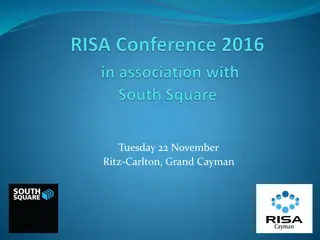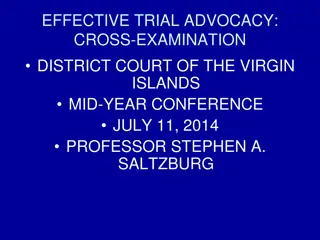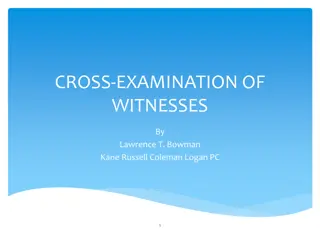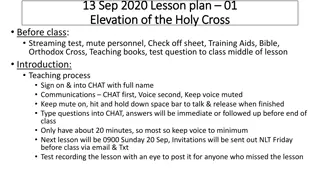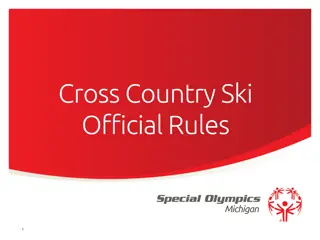Essential Steps for Organizing a Cross Country Meet
When setting up a cross country meet, start by selecting a suitable date and location, securing a site, obtaining a USATF sanction for official recognition, advertising the event effectively, and arranging for a timing and scoring service. By following these key steps and utilizing resources like online platforms for promotion, you can ensure a successful and well-organized event. Remember to plan ahead and prioritize safety measures and logistical details to provide a memorable experience for participants.
Download Presentation

Please find below an Image/Link to download the presentation.
The content on the website is provided AS IS for your information and personal use only. It may not be sold, licensed, or shared on other websites without obtaining consent from the author.If you encounter any issues during the download, it is possible that the publisher has removed the file from their server.
You are allowed to download the files provided on this website for personal or commercial use, subject to the condition that they are used lawfully. All files are the property of their respective owners.
The content on the website is provided AS IS for your information and personal use only. It may not be sold, licensed, or shared on other websites without obtaining consent from the author.
E N D
Presentation Transcript
The Basics of Setting Up a Cross Country Meet
Setting a Time and Securing a Site Go to www.scausatf.org and www.raceplace.com to look at dates of current cross country and races that would compete for participants with you. Make sure to pick a date with as few conflicts with your race as possible. If setting up a race for a school, it should be based around their season schedule. Public Parks, large school grounds, and golf courses are the best bet for a cross country race site. If you don t have a site in mind, you may have to do some research and potential site inspections. The proximity to parking and restrooms should be considered when choosing a site. (The cost of renting Porta-Potties is roughly $100 each.) The application/ approval process to secure a site may take several months so, START EARLY. A 9:00 am start time for your races will likely improve your chances of approval since many public facilities will experience a high volume of foot traffic and activities later in the day.
Applying for a USATF Sanction Once you have a date and site, call the Indianapolis USATF office at (317) 261-0500 and request and application for your race (this is only if you want your race to be official) The cost of the sanction is based on the number of entrants you are anticipating. ($150 for 1-100 entrants, $175 for 101-250, $325 for 251-500, $550 for 501- 1000, and $900 for 1001-2000 entrants.) A USATF sanction provides $1 million in liability coverage for you; the race organizer. It also provides the same insurance coverage for third parties the site or facility owner, a sponsor, or anyone else who might require it at no additional charge.
Advertising and Posting your Race Once you have received your sanction, you can now advertise. There are many sites which you can put your on such as www.raceplace.com, www.runningusa.com, and www.trackinfo.org. You can determine individual and team entry fees based on your expenses. Expenses may include advertising, equipment rentals, sanction cost and your budget for race materials and rewards. Typically it will take up to three years for a new race to build its participation base to where it operates at a profit. Runners Image is a site which has a flyer distribution service you may want to consider. It charges roughly $65 per 1,000 flyers distributed at races prior to yours, and $6 per store, running club, and fitness center to post your flyers. Social media is also a great way to advertise. Facebook, for example, allows you to pay to boost a post. By boosting your post. Facebook will reach out to a target audience. Typically the audience will be people who live within a certain radius of the race as well as those whose searches are focused around fitness.
Secure a Timing/ Scoring Service Securing a Timing service should occur as soon as your receive your USATF sanction. However by purchasing one of Orbiters timing systems you can bypass this step. If you have a smaller race, another option may be to score and time your race by hand however it is much easier to just use a timing system. By using Orbiters system it allows you to enter in teams and once the race is finished you will be able to score the top 5 individuals from each team. You can find out which team won by averaging out the top 5 times for each team.
Developing a Course If your race site does not have a permanent cross country course, you will need to develop one. At the open level, men s courses traditionally measure from 5 Kilometers (3.1 miles) to 10K (6.2 miles) and women s courses from 3K (1.875 miles) to 6K (3.75 miles). Even if there is a traditional course at your site, you may want to design a new course to create a better start/finish line or to take full advantage of the site s space and terrain. It is also good to have a backup course just in case you run across some obstacles when arriving to the site.
Course Design Recommendations A cross country course should be challenging, but safe. Avoid laying out a course where drinking water and bathrooms are unavailable (or be prepared to import them) and where emergency vehicle access is difficult. Avoid using trails or paths that are narrow or rutted, littered with rocks or holes, or adjacent to hazards such as low-hanging tree branches or barbed wire fencing. No portion of the course should be too narrow to accommodate at least 3 competitors running side by side to allow for passing. Narrow bridges and fence openings, steep down-hills, and crossing roads or streets that are open to vehicle traffic should also be avoided.
Course Design Recommendations Continued Consider spectator viewing when designing your course. Don t be afraid to use multiple loops or hourglass and outer-inner loop configurations that repeatedly bring the course back to a central viewing area. Courses with multiple loops should be constructed so that runners will not be likely to lap each other or collide at intersections. Try to avoid courses that may having an intersection as this could cause racers to collide or be blindsided. Ideally, a cross country course should offer varied terrain that challenges the skills of a runner. It should not, however, be an obstacle course or a mountain run. In areas without hills, you can integrate multiple turns, switchbacks, and different surfaces (e.g., grass to dirt to pavement) into the course to create variety and pace changes.
Course Design Recommendations Continued Every course should have a long, wide starting area and finishing straight. At the start, the course should not narrow, turn, or ascend a hill for at least 150 meters. The start and finish should be located relatively close to one another. For accuracy, measure the course with a calibrated measuring wheel, not with an automobile or bicycle odometer. It is not important, however, that the course measure precisely 3K, 5K, 6K, 8K, or 10K in distance. What is important is that everyone in a given race runs the same course. If you have a multiple loop course, a new course, or course markings short of a white line from start to finish, it is highly recommended that you have a cyclist on a mountain bike serve as a lead vehicle for the front-runners to follow in each race, start-to-finish.
Recruiting Volunteers It takes a small army to conduct a cross country race. You will need assistants to help mark the course before the race and to collect those materials afterwards. You will need people to check-in runners before the race who have pre-registered, to register those who have not, and to collect entry fees. You will need a Starter, who will also serve as Referee. The starter does not need to be a USATF- certified official, but it is recommended. As Race Director, it is not recommended that you fulfill the role of starter/referee yourself. Whoever does serve as starter needs to know USATF cross country rules and how to resolve protests and make disqualifications. It is highly recommended that you have a sound system (even if its just a powerful, portable megaphone) and a Race Announcer to advise spectators of the progress of each race, announce the leading individual runners and teams at various stages, identify finishers as they cross the finish line, announce results, and make awards presentations. You will need Inspectors around the course to observe the conduct of competitors during the race, direct them to follow the correct course at confusing points, and ensure runners go around the flags or cones placed at each turn. Inspectors report any infraction to the Referee, who then makes rulings on disqualification.
Recruiting Volunteers Continued You will need Split Timers to call off all runners times at the mile marks along the course, or clocks set up at the mile markers. You will need Spotters with walkie-talkies to relay the front runners race numbers to the announcer at various stages of the race. You will need a Finish Judge to determine the correct order of finish at the finish line. For most meets, this can be the Starter/Referee. The Finish Judge stands at one end of the finish line and judges the order of close finishes. His or her decision is final. The best way for the Finish Judge to convey this information to the Chute Monitors (positioned at the neck of the chute to place finishers in the correct order and assure no switching of positions takes place) is to call jersey colors in the order of finish (for instance, Red-Blue ). You will need a Tag Stewart positioned at the end of the chute to tear-off the name tag at the bottom of each runner s race number and place it on a spindle (which looks like a large safety pin) in the order of finish. You will also need a Race Number Recorder to provide a backup order of finish list. You should also have Medical Personnel on hand to deal with injuries or a medical emergency. That can be an attending physician, athletic trainer, or certified EMS professional. And finally, you will need help to pick up trash after the race if you want to avoid being charged a clean-up fee. All of these last steps are assuming that you are not using timing system. Using Orbiter comes at a great advantage as you will be using a chip timer meaning the sensor does all the work for you by catching the participants times.
Race Materials Checklist Prior to your race, you will need to produce, purchase, rent, or borrow all of the following materials Volunteers Assignment sheet Race Packets: which should include information sheet, course map, race number (and 4 safety pins to attach it), for each individual runner or the members of each team entered. You will need to prepare additional packets for runners who register the day of the race. List of pre-registered teams and runners for your registration desk and announcer. Pens and extra race numbers for the registration desk
Race Materials Checklist Continued Notepads & pens for Inspectors to record the race numbers of runners who commit infractions during the race. Cash box with receipts and adequate change. Table & chairs for your Registration and Timing/Scoring Areas. Table for water jugs at the end of the finish chute. Table Signage and scotch tape. Announcer s Packet: Race schedule, entry lists with race numbers, and course records.
Race Materials Checklist Continued Megaphone or sound system. Some form of communication (walkie-talkies) for spotters to relay the front- runners race numbers at points around the course to the announcer. Stopwatches: for the split-callers at the mile marks. Starting pistol & blanks or an air horn. Water jugs, cups, and a trash can at the end of the finish chute. Flag posts with colored flags and/or arrowed-signs or cones to mark the turns. Stakes for the finish chute and rope or line pennants to string between them. Chalker or spray paint striper to mark the start and finish lines and course intersections. Awards
Marking the Course Your first responsibility as Race Director is to provide a safe, well- marked course for your participating runners. The next step is to mark it properly. You can purchase course-marking materials from a number of different manufacturers or wholesalers, or perhaps you can borrow those materials from a nearby college or high school cross country team. Materials include 5 long steel directional flag posts with colored flags, 4 long chute posts, colored line pennants, and nylon rope. (Old golf bags are perfect for storing flag posts & chute stakes and moving them around the course.)
International Rules and Requirements You may not be aware that there are international rules and requirements for marking a cross country course. The basic rules are: A 12-inch colored flag 4-feet above the ground must always be in view on the course: BLUE flag= Straight ahead, YELLOW flag= Right turn, and RED flag= Left turn. There can be no ground obstructions that can trip or injure a runner. Turns and intersections must be marked with materials that won t harm the eyes or skin. The starting line should be wide enough to accommodate at least 3- runners from each team on the front line. The distance from either end of the starting line to the first turn or narrowing point of the course should be the same.
Chalk, Spray Paint, or Signage Make sure that prior to the race you know what the race site allows in terms of marking the course. Many courses will not allow chalk or spray paint as it takes a while for it to go away. Alternative options to chalk or spray paint are small flags, sandwich boards with signage or cones. To mark areas where the course crosses pavement surveyors tape is a good option.
Set up the Finish Chute After providing a safe, well-marked course, your next priority as Race Director is providing a finish line chute that accurately records the place and time of each finisher. The recommended width or the finishing line is 15-feet wide. You want to make the chute long in order to prevent a build up of runners. It is recommended to have a few volunteers on hand to help runners through the chute if they collapse from fatigue.
Reference USATF. http://www.archive.scausatf.org/pdf/organizexc.pdf








